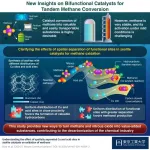(Press-News.org) “I consider the drugs available on the marked today as the first generation of weight-loss drugs. Now we have developed a new type of weight-loss drug that affects the plasticity of the brain and appears to be highly effective.”
So says Associate Professor and Group Leader Christoffer Clemmensen, from the Novo Nordisk Foundation Center for Basic Metabolic Research at the University of Copenhagen, who is senior author of the new study, which has been published in the prestigious scientific journal Nature.
In the study, Christoffer Clemmensen and colleagues demonstrate a new use of the weight loss hormone GLP-1. GLP-1 can be used as a ‘Trojan Horse’ to smuggle a specific molecule into the brain of mice, where it successfully affects the plasticity of the brain and results in weight loss.
“The effect of GLP-1 combined with these molecules is very strong. In some cases, the mice lose twice as much weight as mice treated with GLP-1 only,” Christoffer Clemmensen explains.
This means that future patients can potentially achieve the same effect with a lower dosage. Moreover, the new drug may be an alternative to those who do not respond well to existing weight-loss drugs.
“Our studies in mice show side effects similar to those experienced by patients treated with the weight loss drugs available on the market today, including nausea. But because the drug is so effective, we may be able to lower the dosage and thus mitigate some of the side effects in the future – though we still don’t know how humans respond to the drug,” he says.
Testing of the new weight loss drug is still in the so-called preclinical phase, which is based on studies with cells and on experimental animals. The next step is clinical trials with human participants.
“We already know that GLP-1-based drugs can lead to weight loss. The molecule that we have attached to GLP-1 affects the so-called glutamatergic neurotransmitter system, and in fact, other studies with human participants suggest that this family of compounds has significant weight loss potential. What is interesting here is the effect we get when we combine these two compounds into a single drug,” Christoffer Clemmensen stresses.
The drug must undergo three phases of clinical trials on human participants. According to Christoffer Clemmensen, it can therefore take eight years before the drug could be available on the market.
What is neuroplasticity?
The plasticity of the brain, also known as neuroplasticity, is the brain’s ability to restructure itself by forming new neural connections. This ability allows the brain to adjust to new experiences, learn new skills, absorb new information and recover from injuries.
Neuroplasticity is found in several levels of the nervous system and can be anything from microscopic changes in the structure and function of individual neurons to major changes such as the formation of new neural connections or reorganisation of areas of the brain.
The brain defends excessive body weight
Christoffer Clemmensen and colleagues developed an interest in molecules that are used to treat chronic depression and Alzheimer’s disease.
The molecules block a receptor protein called the NMDA receptor, which play a key role in long-term changes in brain connections and have received scientific attention within fields of learning and memory. Drugs targeting these receptors will strengthen and/or weaken specific nerve connections.
“This family of molecules can have a permanent effect on the brain. Studies have demonstrated that even a relative infrequent treatment can lead to persistent changes to the brain pathologies. We also see molecular signatures of neuroplasticity in our work, but in this case in the context of weight loss,” he explains.
The human body has evolved to protect a certain body weight and fat mass. From an evolutionary perspective, this has probably been to our advantage, as it means that we have been able to survive periods of food scarcity. Today, food scarcity is not a problem in large parts of the world, where an increasing part of the population suffers from obesity.
“Today, more than one billion people worldwide have a BMI of 30 or more. This makes it increasingly relevant to develop drugs to aid this disease, and which can help the organism to sustain a lower weight. This topic is something we invest a lot of energy in researching,” says Christoffer Clemmensen.
A Trojan Horse smuggles small molecule modulators of neuroplasticity into appetite-regulating neurons
We know that drugs based on the intestinal hormone GLP-1 effectively target the part of the brain that is key to weight loss, namely the appetite control centre.
“What is spectacular – on a cellular level – about this new drug is the fact that it combines GLP-1 and molecules that block the NMDA receptor. It exploits GLP-1 as a Trojan Horse to smuggle these small molecules exclusively into the neurons that affect appetite control. Without GLP-1, the molecules that target the NMDA receptor would affect the entire brain and thus be non-specific,” says Postdoc Jonas Petersen from the Clemmensen Group, who is the first author on the study and the chemist who synthesized the molecules.
Non-specific drugs are often associated with severe side effects, which has previously been seen in drugs for treating different neurobiological conditions.
“A lot of brain disorders are difficult to treat, because the drugs need to cross the so-called blood-brain barrier. Whereas large molecules like peptides and proteins generally have difficulties accessing the brain, many small molecules have unlimited access to the entire brain. We have used the GLP-1 peptide’s specific access to the appetite control centre in the brain to deliver one of these otherwise non-specific substances to this region only,” Christoffer Clemmensen says and adds:
“In this study, we have focused on obesity and weight loss, but in fact this is a completely new approach for delivering drugs to specific parts of the brain. So, I hope our research can pave the way for a whole new class of drugs for treating conditions like neurodegenerative diseases or psychiatric disorders.”
Christoffer Clemmensen, along with postdoc Jonas Petersen and a former scientist from the University of Copenhagen (Anders Klein), have co-founded of the biotech company Ousia Pharma, which is a spinout company from the University of Copenhagen. The company is continuing to develop the medical concept presented in this study for the treatment of severe obesity.
END
'Trojan horse' weight loss drug more effective than available therapies
A groundbreaking paper in Nature describes a promising new therapy for obesity that leads to greater weight loss in mice than existing medications. The approach smuggles molecules into the brain's appetite centre and affects the brain's neuroplasticity.
2024-05-15
ELSE PRESS RELEASES FROM THIS DATE:
Reduced risk of breast cancer following bariatric surgery in women with hyperinsulinemia
2024-05-15
Bariatric surgery is associated with a reduced risk of breast cancer in women with obesity. These are the findings of a study conducted at the University of Gothenburg. The risk reduction is greatest for those with high blood insulin levels at the time of surgery.
The study, published in JAMA Surgery, is based on data from 2,867 women with obesity, half of whom had undergone bariatric surgery at 25 surgical departments. The remaining women, comprising the control group, received standard obesity treatment at 480 healthcare centers. The groups were otherwise comparable in terms of age and body composition.
The results show that a total of ...
Copper can't be mined fast enough to electrify the US
2024-05-15
Copper cannot be mined quickly enough to keep up with current U.S. policy guidelines to transition the country's electricity and vehicle infrastructure to renewable energy, according to a University of Michigan study.
The Inflation Reduction Act, signed into law in 2022, calls for 100% of cars manufactured to be electric vehicles by 2035. But an electric vehicle requires three to five times as much copper as an internal combustion engine vehicle—not to mention the copper required for upgrades to the electric grid.
"A ...
Guideline issued for people with epilepsy who may become pregnant
2024-05-15
EMBARGOED FOR RELEASE UNTIL 4 P.M. ET, WEDNESDAY, MAY 15, 2024
MINNEAPOLIS – A new guideline has been issued to help neurologists and other clinicians determine the best antiseizure medications for people with epilepsy who may become pregnant. The guideline is published in the May 15, 2024, online issue of Neurology®, the medical journal of the American Academy of Neurology (AAN), and was developed through a collaboration between the AAN, the American Epilepsy Society (AES) and the Society for Maternal-Fetal Medicine (SMFM). It was endorsed by the Child Neurology Society.
The guideline partially updates two 2009 AAN and AES ...
Only 20% of U.S. nonprofit hospitals invested in housing as part of the federal community benefit mandate
2024-05-15
Waltham — May 15, 2024 — A nationwide assessment of how nonprofit hospitals are addressing housing-related needs in their communities appears in the latest issue of Medical Care, the official journal of the Medical Care Section of the American Public Health Association. The journal is published in the Lippincott portfolio by Wolters Kluwer.
"Approximately 60% of hospitals in the United States are 501(c)(3) nonprofit organizations ...
The crystallization of memory: Study reveals how practice forms new memory pathways in the brain
2024-05-15
A new study led by UCLA Health has shown that repetitive practice not only is helpful in improving skills but also leads to profound changes in the brain’s memory pathways.
The research, published in the journal Nature and co-led by Rockefeller University, sought to unravel how the brain’s ability to retain and process information, known as working memory, improves through training.
To test this, researchers tasked mice with identifying and recalling a sequence of odors over the course of two weeks. Researchers then tracked neural activity in the animals as they practiced the task by using a novel, custom-built microscope that can image cellular activity ...
Dartmouth-led study provides new insights into phage therapy design
2024-05-15
Results from a new Dartmouth-led study, involving collaborators at the University of Pittsburgh and Yale University and published in the journal PLOS Biology, are providing new insights into the therapeutic potential of bacteriophage (phage) therapy for treating diseases like cystic fibrosis (CF).
A major challenge of treating people with CF—an inherited disease that causes sticky, thick mucus to build up in the lungs—are the persistent infections the disease causes which can lead to respiratory failure and death.
“Opportunistic ...
This time, it’s personal: Enhancing patient response to cancer immunotherapy
2024-05-15
LA JOLLA (May 15, 2024)—Immunotherapy has revolutionized the way we treat cancer in recent years. Instead of targeting the tumor itself, immunotherapies work by directing patients’ immune systems to attack their tumors more effectively. This has been especially impactful in improving outcomes for certain difficult-to-treat cancers. Still, fewer than half of all cancer patients respond to current immunotherapies, creating an urgent need to identify biomarkers that can predict which patients are most likely to benefit.
Recently, scientists have noticed that patients whose tumors have a mutation in a gene called ARID1A are ...
A novel multifunctional catalyst turns methane into valuable hydrocarbons
2024-05-15
Methane, a greenhouse gas that contributes significantly towards global warming, is also an important source of energy and an essential chemical resource. When used as a chemical feedstock, methane is typically converted into methanol first and then into hydrocarbons. However, this sequential conversion requires complex industrial setups. More importantly, since methane is a very stable molecule, its conversion into methanol requires tremendous amounts of energy when using conventional means, such ...
Two decades of studies suggest health benefits associated with plant-based diets
2024-05-15
Vegetarian and vegan diets are generally associated with better status on various medical factors linked to cardiovascular health and cancer risk, as well as lower risk of cardiovascular diseases, cancer, and death, according to a new review of 49 previously published papers. Angelo Capodici and colleagues present these findings in the open-access journal PLOS ONE on May 15, 2024.
Prior studies have linked certain diets with increased risk of cardiovascular disease and cancer. A diet that is poor in plant products and rich in meat, refined grains, sugar, and salt is associated with higher risk of death. Reducing consumption of animal-based ...
Bluetooth tracking devices provide new look into care home quality
2024-05-15
Wearable Bluetooth devices can shed light on the care that residents of care homes are receiving and which residents are most in need of social contact, according to a new study published this week in the open-access journal PLOS ONE by Carl Thompson of University of Leeds, UK.
In the UK alone, nearly half a million people reside in some form of care home, including long-term care facilities, nursing homes and residential homes. There is no single reliable method that works well to evaluate care home quality, in part because care homes are complex social systems with diverse interacting groups.
In the new study, researchers tested the feasibility of collecting social network ...
LAST 30 PRESS RELEASES:
Norbert Holtkamp appointed director of Fermi National Accelerator Laboratory
New agentic AI platform accelerates advanced optics design
Biologists discover neurons use physical signals — not electricity — to stabilize communication
Researchers discover that a hormone can access the brain by hitchhiking
University of Oklahoma researcher awarded funding to pursue AI-powered material design
Exploring how the visual system recovers following injury
Support for parents with infants at pediatric check-ups leads to better reading and math skills in elementary school
Kids’ behavioral health is a growing share of family health costs
Day & night: Cancer disrupts the brain’s natural rhythm
COVID-19 vaccination significantly reduces risk to pregnant women and baby
The role of vaccination in maternal and perinatal outcomes associated with COVID-19 in pregnancy
Mayo Clinic smartwatch system helps parents shorten and defuse children's severe tantrums early
Behavioral health spending spikes to 40% of all children’s health expenditures, nearly doubling in a decade
Digital cognitive behavioral treatment for generalized anxiety disorder
Expenditures for pediatric behavioral health care over time and estimated family financial burden
Air conditioning in nursing homes and mortality during extreme heat
The Alps to lose a record number of glaciers in the next decade
What makes a good proton conductor?
New science reporting guide published for journalists in Bulgaria
New international study reveals major survival gaps among children with cancer
New science reporting guide published for journalists in Turkey
Scientists develop a smarter mRNA therapy that knows which cells to target
Neuroanatomy-informed brain–machine hybrid intelligence for robust acoustic target detection
Eight SwRI hydrogen projects funded by ENERGYWERX
The Lundquist Institute and its start-up company Vitalex Biosciences Announces Strategic Advancement of Second-Generation fungal Vaccine VXV-01 through Phase 1 Trials under $40 Million Competitive Con
Fine particles in pollution are associated with early signs of autoimmune disease
Review article | Towards a Global Ground-Based Earth Observatory (GGBEO): Leveraging existing systems and networks
Penn and UMich create world’s smallest programmable, autonomous robots
Cleveland researchers launch first major study to address ‘hidden performance killer’ in athletes
To connect across politics, try saying what you oppose
[Press-News.org] 'Trojan horse' weight loss drug more effective than available therapiesA groundbreaking paper in Nature describes a promising new therapy for obesity that leads to greater weight loss in mice than existing medications. The approach smuggles molecules into the brain's appetite centre and affects the brain's neuroplasticity.



